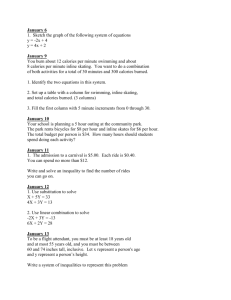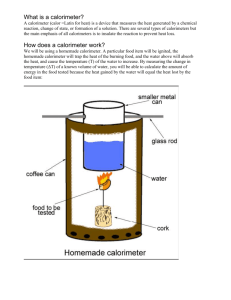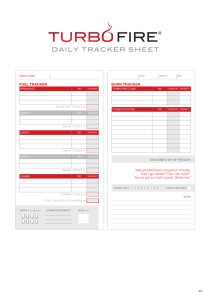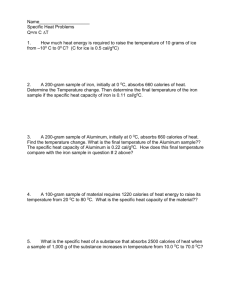Energy Balance - studentorg
advertisement
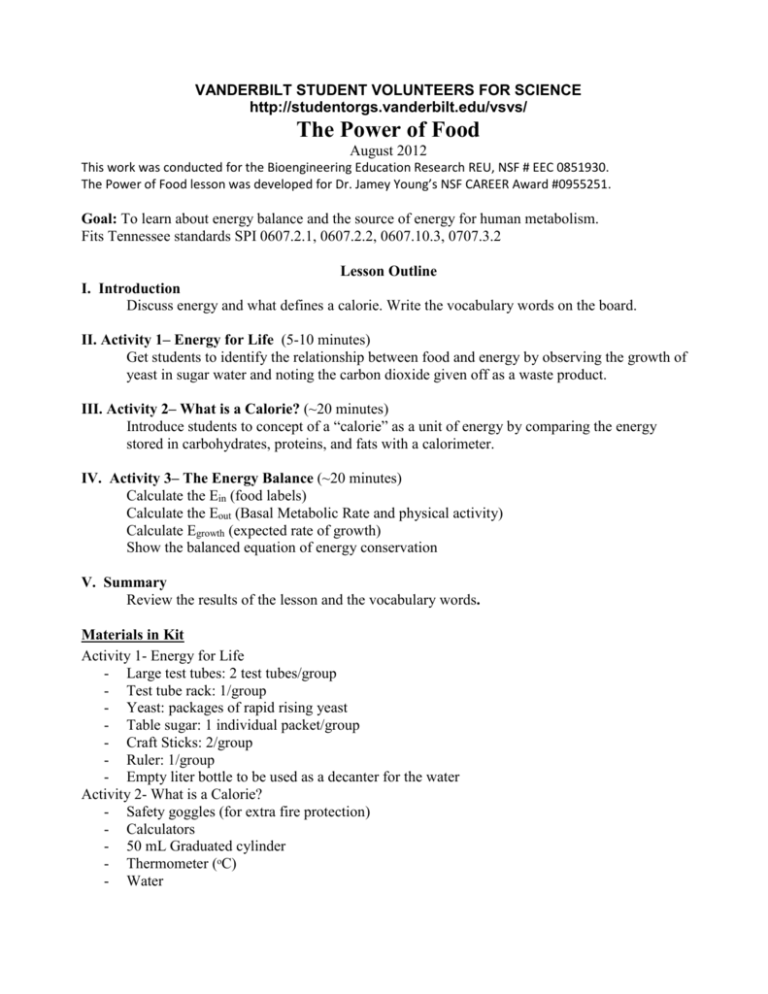
VANDERBILT STUDENT VOLUNTEERS FOR SCIENCE http://studentorgs.vanderbilt.edu/vsvs/ The Power of Food August 2012 This work was conducted for the Bioengineering Education Research REU, NSF # EEC 0851930. The Power of Food lesson was developed for Dr. Jamey Young’s NSF CAREER Award #0955251. Goal: To learn about energy balance and the source of energy for human metabolism. Fits Tennessee standards SPI 0607.2.1, 0607.2.2, 0607.10.3, 0707.3.2 Lesson Outline I. Introduction Discuss energy and what defines a calorie. Write the vocabulary words on the board. II. Activity 1– Energy for Life (5-10 minutes) Get students to identify the relationship between food and energy by observing the growth of yeast in sugar water and noting the carbon dioxide given off as a waste product. III. Activity 2– What is a Calorie? (~20 minutes) Introduce students to concept of a “calorie” as a unit of energy by comparing the energy stored in carbohydrates, proteins, and fats with a calorimeter. IV. Activity 3– The Energy Balance (~20 minutes) Calculate the Ein (food labels) Calculate the Eout (Basal Metabolic Rate and physical activity) Calculate Egrowth (expected rate of growth) Show the balanced equation of energy conservation V. Summary Review the results of the lesson and the vocabulary words. Materials in Kit Activity 1- Energy for Life - Large test tubes: 2 test tubes/group - Test tube rack: 1/group - Yeast: packages of rapid rising yeast - Table sugar: 1 individual packet/group - Craft Sticks: 2/group - Ruler: 1/group - Empty liter bottle to be used as a decanter for the water Activity 2- What is a Calorie? - Safety goggles (for extra fire protection) - Calculators - 50 mL Graduated cylinder - Thermometer (ᵒC) - Water - Pieces of food cut or weighed to be similar o Popcorn o Nut Activity 3- Energy Balance - Food labels for Energy Intake approximations - Worksheets for Activity 3 - Calculators I. Introduction Do not hand out any materials until you have discussed the following background information. Write the following vocabulary words on the board: energy and calorie Ask students to tell you what they know about energy, and where it comes from. Make sure the following is included in the responses: Energy allows us, or provides us with the ability, to do work. Energy maybe stored for later use or it may be used immediately to do something such as provide light, heat, or motion. Students may view energy as something that lets you do things like run, walk, or just stay alive! Important Note: Divide students into groups of 3-4 so that there are 7-8 groups. There are 8 sets of materials for pairs of students within groups to do the activities. Students will be working in pairs, so that each pair of students in the group will do the calculations together. II. Activity 1- Energy for Life Materials - Worksheet for Activity 1 - Large test tubes: 2 test tubes/group - Test tube rack: 1/group - Yeast: packages of rapid rising yeast - Table sugar: 1 individual packet/group - Empty liter bottle to be used as a decanter - Warm water (recommended to be obtained from the warm tap of a faucet) - Craft Sticks: 2/group - Ruler: 1/group Pass out worksheets, as you initiate the pre-lab discussion: Tell the class they will be investigating the behavior of a common fungus, baker’s yeast, when it is fed. Ask the class to share anything they know about yeast and to answer the hypothesis questions. (What do you think will happen when yeast is combined with water alone? What do you think will happen when sugar and water are added to the yeast?) Instructions 1. Have the test tube racks set up for the students with two large test tubes in each rack. 2. Put one scoop of yeast into each test tube using the yellow scooper 3. Use the empty liter bottle as a decanter and fill it with warm water 4. Pour warm water into each test tube up to the marked line (approximately 50mL) 5. Have students stir the mixtures gently with the craft sticks 6. Students add a sugar packet to one of the test tubes and again gently stir. Make sure they note which test tube contains the sugar 7. Have each group measure the height of the mixture in each test tube; record this height as initial height in the second table of the Activity 1 worksheet. 8. Have them check the height after about five minutes (before they start the calculations for energy balance). a. If the reaction is slow to occur set the test tube rack off to the side and begin Activity 2. Return to Activity 1 after there is a noticeable change in height. Have students note the final height on the Activity 1 worksheet. b. Tubes may overflow. While waiting for the yeast to react initiate a discussion Possible Questions What are the basic needs of living things? Do all organisms need exactly the same things to live? What do plants need? What about animals? Do animals need the same things as plants? Possible Answers All organisms need energy. Plants are producers, meaning they are able to produce everything they need from very basic raw materials, including carbon dioxide from air, water, nutrients from soil and energy from sunlight through a process known as photosynthesis. Animals that rely on photosynthetic organisms as their source of energy are called consumers, this also includes fungi. Producers get theirs from the sun and consumers get it from eating the appropriate foods. Check back on the yeast. If there is a noticeable change in height ask the students the following: Ask “What is happening to the yeast?” The yeast cells have begun to grow and multiply in the presence of water and food (sugar). The gas being produced is carbon dioxide. Help them understand, that they used different pieces of evidence to come to the conclusion that yeast uses sugar as an energy source. - First, the yeast was breaking down sugar to obtain energy, and released carbon dioxide (visible as bubbles, increasing the height of the mixture). - Second, the yeast-sugar mixture became warmer over the course of the lesson. Heat was released as a by-product of the energy conversion. - Third, the yeast mixture with no sugar did not have energy to grow, and so the mixture did not have bubbles or increase in temperature. Tell students that yeast used sugar as their food source in order to produce a noticeable energy output. Ask what the students use as their energy source? Ask how are they similar to the yeast? How are they different? III. Activity 2 - What is a Calorie? Materials Safety goggles (for extra fire protection even though students NEVER handle flames themselves) 50 mL Graduated cylinder 6-inch thermometer (ᵒC) Water Copies of worksheet for Activity 2 Pieces of food cut or weighed to be similar - Popcorn - Nut o Use only a quarter of a walnut by breaking the provided nuts in half. This will prevent the water from getting too hot. Don’t let the temperature of the water go above 100 degrees Celsius. Remove the water from the heat source if you see the water start to boil. Only spend a maximum of 5 minutes explaining and discussing the following: Ask: How do we measure energy? 1 calorie is the amount of energy it takes to raise the temperature of one milliliter of pure water one degree Celsius at sea level. 1 food Calorie is equal to 1,000 calories o Note that a food Calorie has a capital “C” whereas the other is lowercase o The calorimeter will calculate calories, make sure to convert this answer to food Calories (by moving the decimal place to the left three places) Emphasize that food provides energy for living things, and that energy is never lost. Ask: What do we mean when we say, “energy is never lost?” Energy is a measure of the amount of “work” something can do; in this case the energy in the food is a chemical potential energy that will be used to heat the water. Introduce the calorimeter and explain that we can measure the amount of energy in a piece of food by measuring the change in temperature as the fire (from the burning piece of food) heats the water. Show the two different pieces of food and ask if they think all foods have the same amount of energy. Hypothesize the number of calories in each piece of food based on the three choices given on the worksheet. Which food provides the largest amount of energy? Calorimeter demonstration 1. Assemble components of calorimeter. 2. Pour 50 mL of water into the flask. 3. Measure the temperature of the water using the thermometer. Record this initial temperature on the board and have students note the temperature in the second table of the Activity 2 worksheet. 4. Attach the food to the pin attached to the cork. 5. Use the match (or stick lighter) to light the piece of food on fire. 6. Pull the calorimeter over the lit piece of food making sure the food is still visibly burning through the triangular shaped slit in the heat shield 7. Once the food has been burned completely, record the final temperature of the water. The popcorn burns for less than a minute. The nut can burn as long as three or four minutes. Tell students a calorie is the amount of energy required to raise the temperature of one mL of water by one degree Celsius. Based on this information and your investigation: Do the mathematical calculations for this on the board, walking them through the following steps: Q = heat (cal) ρ= density of water 1g/mL C = specific heat of water (1 cal/g°C) ∆T = change in temperature (°C) Explain density as the amount of mass in a given volume. Example: 300 grams of marbles in a 100 mL container is 300g/100mL or a density of 3g/mL. Note water’s density is 1g/mL Explain specific heat as the energy required to raise the temperature of an object by a certain amount. Example water (1 cal/g ºC) is different than copper (0.09 cal/g ºC) Ask students to solve the ΔT for you, using the second table on the Activity 2 worksheet. Explain Δ (delta) just means the change in. Walk students through how to set up the equation and solve for the unknown variables. Ask them to record the answer on their worksheet. This equation will show students how to calculate the amount of Calories in a piece of food. This should give students a better grasp of the concept of food Calories as listed on nutrition labels 𝑸 = 𝝆𝑪∆𝑻 Q = (1 g/mL)(50 mL)(1 cal/g°C)(ΔT) In words: calories equal density of water times the amount of water we used times the specific heat of water times the change in temperature of the water Q = ____ cal Next convert the calories calculated to food Calories. Remind the students that 1 food Calorie is equivalent to 1,000 calories Food Calories = (cal) (0.001) In words: Food Calories equal the answer for Q from the above equation times 0.001 Or Take the answer for Q from the above equation and move the decimal to the left three places Example problem using popcorn The density of water is one times the amount of water, which is 50 mL, times the specific heat of water, which is one, times the temperature change of the water when popcorn is used as a heat source, which is three degrees. Therefore Q = (1) (50) (1) (3) Q = 150 calories Now to convert to food Calories: Food Calories = (150)(0.001) Food Calories = 0.15 Calories Thus a single piece of popcorn is 0.15 Calories Repeat calculations for the second piece of food. Have students record the Caloric value for each piece of food in the first table of the Activity 2 worksheet. Discussion: Which food contained the most Calories? Write the following vocabulary words on the board: carbohydrates, proteins, fats Carbohydrates, fats, and proteins are the primary sources of energy in food. Fats and oils provide about nine cal/g Proteins and carbohydrates each provide four cal/g Sugars, starches, and fiber are the main source of carbohydrates. Carbohydrates provide most people with about 50% of their energy needs. Foods rich in carbohydrates include: pasta, potatoes, and bread Foods rich in fat include: oil, butter and cream. Protein is found in meat, eggs, nuts and beans. Fats are a good source of energy, but certain fats are healthier than others. o Fats that are solid at room temperature, such as lard, shortening, and margarine should be avoided, as well as the fats found in some red meats, chocolate, cake, cookies and some crackers. o Healthier options include olive, nut, or fatty fish oils. IV. Activity 3—Energy Balance A) Predict Energy intake Materials: Food labels Worksheet for Activity 3 Pass out food labels to each group of students. NOTE: Tell the students to look at the copy of the food label sheet and discuss how to read a label to determine how many calories there are in each type of food. Briefly have them note the percent of protein, carbohydrates, etc. Make sure to mention how the nut and the popcorn experiment they just conducted relates to the food labels passed out. For example, nuts are high in fat and oil, thus why it was able to burn so well (and why it had a high calorie content). The popcorn on the other hand is mostly a carbohydrate, but unlike carbohydrates such as pasta or potatoes, popcorn is very light and doesn’t provide the flame with much fuel (thus it did not have as high of a caloric value). Make sure to mention that just because a particular food choice has fewer calories does not mean it is better for you. Students should try to eat food from all the food groups: protein, carbohydrates, fats, etc in moderate amounts to get all the nutrients that they need to continue growing and to stay healthy. B) Calculating Energy output Materials: Worksheet for Activity 3 Calculators The Energy Balance Equation Ein = Eout - Shows the relationship between energy input (Ein) and energy output (Eout) Energy input and output are expressed in Calories. Adults who consistently consume more Calories than they expend are in positive energy balance: Ein > Eout. They GAIN weight. Adults who consistently expend more Calories than they consume are in negative energy balance: Ein < Eout. They LOSE weight. Multiple factors make up the Energyout component of the equation. First there is the number of calories your body needs while at rest. This form of energy usage is called the Basal Metabolic Rate (BMR) which uses energy to perform functions such as breathing, digestion, and heart beat that you do not consciously control yet are continuously doing. BMR’s vary from person to person but we can get a close approximation using an individual’s age, gender, height, and weight. Everyone will calculate their own BMR on the worksheet for Activity 3. Make sure each group has access to at least two calculators and help them with their math. Additionally help students figure out how tall they are in inches (5ft.= 60 in) and how much they weigh. The other component of Energyout is the amount of physical activity an individual does each day. When someone runs, jumps, or goes for a bike ride they are using energy in order to do each task. Thus the more difficult the activity the more energy an individual will use to perform it, so they need to consume more Calories to supply their body with the energy it needs. Have students select their activity level from the three choices on the Activity 3 worksheet. Their relative activity level will be multiplied by their calculated BMR in order to determine their total Energyout. Explain to students that in order to grow properly and maintain a healthy state, children, adolescents, and teenagers must be in positive energy balance: Ein > Eout. They need to consume more Calories than needed for BMR and physical activities (Eout) because the extra calories they consume are used for increasing the amount of important body tissues such as bone, muscle, and blood needed for growth (Egrowth). An approximation of growth rates for both males and females is on the second page of the Activity 3 worksheet. If there are still more Calories taken in than used in for either Energyout or Energygrowth they may be stored as fat (Estored). Remember energy is never lost so the calories must go somewhere if not used for growth, basic bodily functions, or during physical activity. For healthy children, adolescents, and teenagers, the energy balance equation is: Ein = Eout + Egrowth + Estored Have students fill in this equation using their own energy levels they have just calculated on the seesaw diagram at the end of the second page of the Activity 3 worksheet. **Adapted from the National Institutes of Health, “The Science of Energy Balance,” and Biology Teacher Resources from Baylor College of Medicine, “The Science of Food and Fitness.” Lesson developed for VSVS by: Jessica Campos of Vanderbilt University ’12 and Jackie Whitehead of California Lutheran University ’13 for Dr. Jamey Young’s NSF CAREER Award #0955251 Activity 1 Energy for Life Hypothesis: What do you think will happen when yeast is combined with water alone? What do you think will happen when sugar and water are added to the yeast? Write your predictions below: Experiment Predictions Yeast + Water Yeast + Water + Sugar Observations: Time (min) Yeast + Water Height (mm) Yeast + Water + Sugar Height (mm) Initial Final Discussion: Did your observations match your predictions? Explain why or why not. _________________________________________________________________________________ _______________________________________________________________________________ Conclusion: Why did adding the sugar affect the yeast? _________________________________________________________________________________ _________________________________________________________________________________ _________________________________________________________________________________ What is a Calorie? First circle a prediction of about how many Calories you think are in each piece of food. After the calorimeter demonstration record the number of Calories calculated. Prediction of Calorie content Popcorn 1 10 100 Nut 5 50 500 Number of Calories according to the calorimeter Record the temperature of the water used by the calorimeter before the food is lit on fire (initial). Record the temperature of the water after the food has burned completely (final). Calculate final minus initial (change in temperature). Initial temperature of water Final temperature of water Change in temperature (ΔT) Popcorn Nut Is there a big difference between the calories in popcorn and a nut? Why? _________________________________________________________________________________ _________________________________________________________________________________ _________________________________________________________________________________ What are some foods you eat that you think have a high calorie content? Why? _________________________________________________________________________________ _________________________________________________________________________________ Energy Balance Based on your new knowledge of Calories, about how many Calories do you think you eat each day? _________________ (Energy in) To calculate your own Basal Metabolic Rate (BMR) fill in the chart below for your gender Male Female Your weight in pounds: _________ X 6.23 = __________ (A) Your weight in pounds: _________ X 4.35 =__________ (A) Your height in inches: __________ X 12.7 = ___________(B) Your height in inches: __________ X 4.7 = ____________ (B) Your age in years: ___________ X 6.8 = _____________ (C) Your age in years: __________ X 4.7 = ______________ (C) BMR= 66 + A + B – C BMR= 655 + A + B – C BMR=_____________ BMR=_____________ Pick your weekly activity level and multiply that number with your BMR that you calculated above Active 1-3 days a week Active 3-5 days a week Active 6-7 days a week 1.375 1.55 1.725 ________________ X _______________ = ______________________ (Energyout) Weekly activity level BMR Number of Calories you use a day Why do you think BMR is different for males and females? _________________________________________________________________________________ _________________________________________________________________________________ _________________________________________________________________________________ **Adapted from the BMI calculator website: <http://www.bmi-calculator.net/bmr-calculator/> To calculate your own expected rate of growth follow the calculations below: Male Average amount of weight gained by a 12 year-old due to growth= 11 lbs. One pound= 3500 Calories 11 x 3500=__________ extra Calories you need each year to grow Answer divided by 365 equals the number of extra Calories you need to eat each day to grow at an average rate (Energy growth) Energy growth=_________________ Female Average amount of weight gained by a 12 year-old due to growth= 8 lbs. One pound= 3500 Calories 8 x 3500=__________ extra Calories you need each year to grow Answer divided by 365 equals the number of extra Calories you need to eat each day to grow at an average rate (Energy growth) Energy growth=_________________ Add It All Up Fill in your own Ein Energyin =_______ Cal = Eout + Egrowth Energyout =________Cal + Energygrowth =_____ Cal Are both sides of the seesaw above equal for you? Is one side higher? Explain why in terms of energy. (Hint: Ein = Eout + Egrowth + Estored) _________________________________________________________________________________ _________________________________________________________________________________ _________________________________________________________________________________




